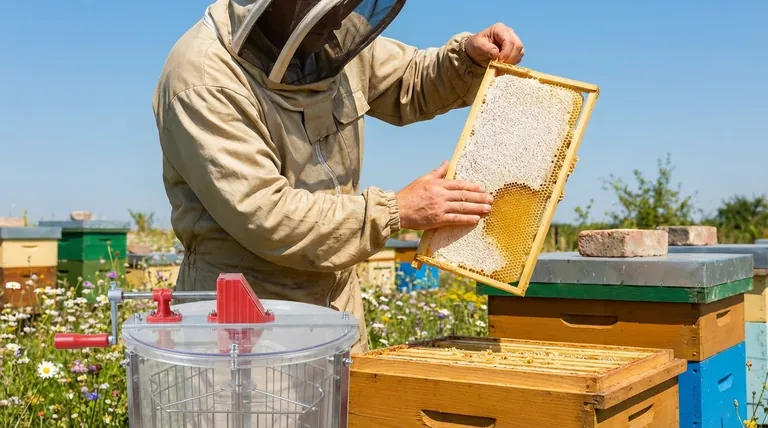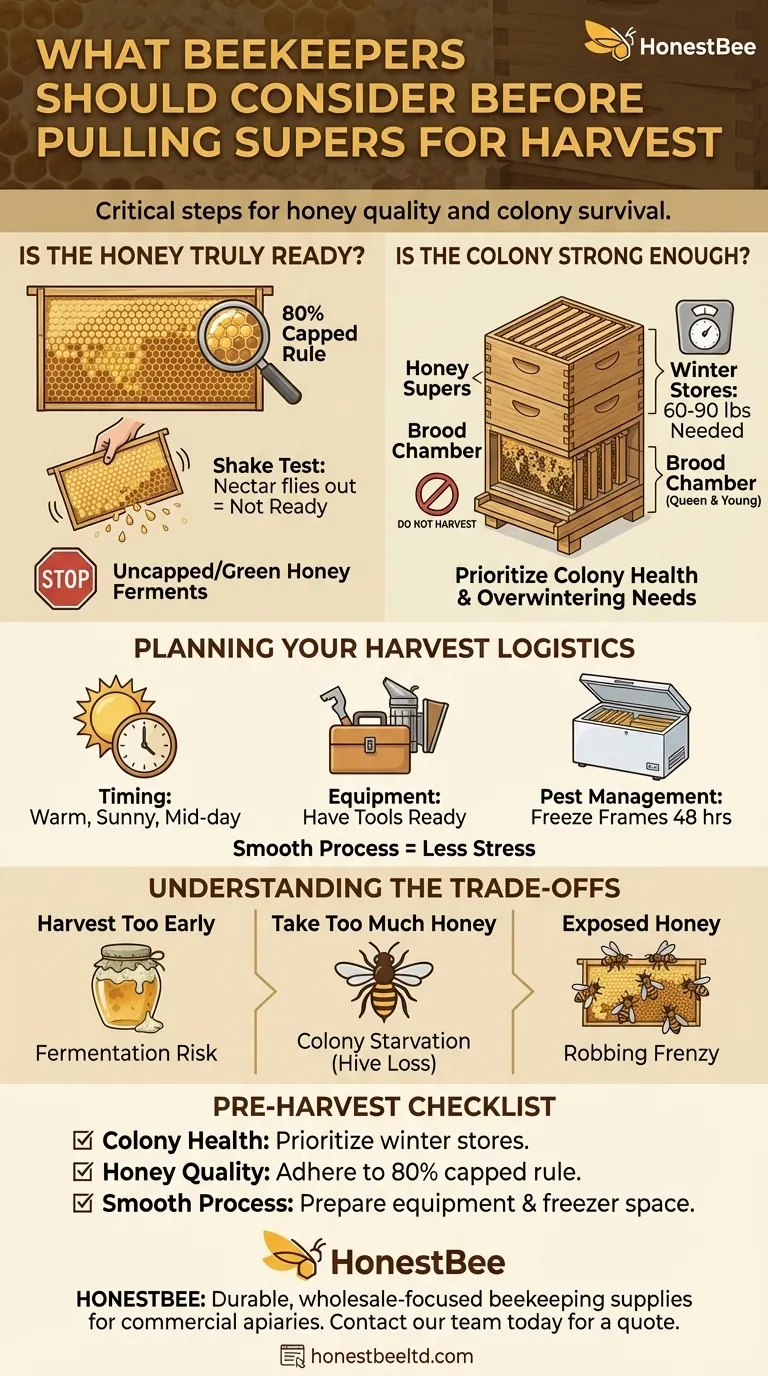Before you pull your honey supers, the most critical considerations are the readiness of the honey, the health and food security of the colony, and your own logistical preparedness. A successful harvest depends on ensuring the honey is fully cured to prevent fermentation and that you leave enough stores for your bees to survive the coming winter.
The decision to harvest honey is not just about taking a sweet reward; it's a critical hive management step that directly impacts the long-term survival of your colony. Proper timing and assessment are paramount.

Is the Honey Truly Ready for Harvest?
The most common mistake new beekeepers make is harvesting honey too early. This "green" or uncured honey contains too much water and will ferment in storage, ruining your entire harvest.
The "Capped Honey" Rule
Bees cap a cell of honey with fresh white beeswax when its moisture content is at the ideal level, typically below 18.6%. This is nature's seal of approval.
The general rule of thumb is to only harvest frames that are at least 80% capped. This ensures the vast majority of the honey is fully cured and stable.
Why Uncapped Honey is a Problem
Uncapped cells often contain nectar that the bees are still dehydrating. Harvesting this nectar along with the honey raises the overall moisture content, creating a perfect environment for yeast to grow and cause fermentation.
The "Shake Test"
For frames with some uncapped cells, you can perform a simple field test. Hold the frame flat over the top of the open hive and give it a firm, downward shake.
If nectar flies out of the uncapped cells, it is not ready. If nothing comes out, the moisture content is likely low enough for safe harvesting.
Is the Colony Strong Enough for a Harvest?
Your primary responsibility is to the health of your bees. Never compromise the colony's winter survival for a larger honey harvest.
Assessing Winter Stores
Honey is the bees' carbohydrate source for winter. A colony needs a significant amount to survive the cold months when they cannot forage.
Depending on your climate, a hive may need between 60 to 90 pounds of honey to overwinter successfully. Always err on the side of leaving too much.
The Queen and Brood Chamber
Never harvest honey from the brood boxes—the lower supers where the queen lays eggs and the colony raises its young. These stores are essential for the immediate needs and development of the hive. Honey should only be taken from the dedicated "honey supers" placed above the brood chamber.
Planning Your Harvest Logistics
A smooth harvest is a well-planned one. Having your process and equipment ready before you open the hive reduces stress on both you and the bees.
Choosing the Right Time and Day
Plan to pull your supers on a warm, dry, and sunny day. Harvesting in the rain is not advisable. The best time is typically mid-day, when a large portion of the forager bees are out of the hive.
Preparing Your Equipment
Have everything you need ready to go. This includes your hive tool, smoker, bee brush or escape board, and a bee-proof container or vehicle to transport the full supers away from the apiary immediately.
Planning for Pest Management
Once honey frames are removed from the hive's protection, they become a target for pests like wax moths. The best way to protect your frames is by freezing them.
Before you pull your supers, ensure you have enough space in a freezer to store the frames for at least 48 hours. This kills any existing wax moth eggs or larvae and is a critical step in preserving your hard work.
Understanding the Trade-offs
Every decision in beekeeping involves balancing benefits and risks. Harvesting is no different.
Harvesting Too Early
The primary risk is fermentation. You will end up with spoiled honey that is unusable. It's always better to wait another week if you are unsure.
Taking Too Much Honey
This is the most serious risk to your colony. Taking too much honey can lead to the colony starving over the winter. This mistake can cost you the entire hive.
Creating a Robbing Frenzy
Exposed honey can quickly attract bees from other hives, initiating a "robbing" event where the invading bees try to steal the honey. This can be a violent, destructive frenzy that can overwhelm and destroy a weaker colony. Work quickly and keep all honey supers covered.
A Final Pre-Harvest Checklist
Use these points to guide your decision-making process for a harvest that is rewarding for you and responsible for your bees.
- If your primary focus is colony health: Prioritize leaving ample winter stores above all else and only harvest from strong, thriving hives.
- If your primary focus is honey quality: Strictly adhere to the 80% capped rule and perform the shake test on any frames with uncapped cells.
- If your primary focus is a smooth, low-stress process: Prepare all your equipment, clear freezer space, and choose a warm, sunny day before you approach the hive.
Thoughtful preparation transforms honey harvesting from a simple task into a practice of sustainable and successful beekeeping.
Summary Table:
| Key Consideration | What to Check For |
|---|---|
| Honey Readiness | Frames are at least 80% capped; perform the shake test. |
| Colony Health | Ensure ample winter stores (60-90 lbs); only harvest from honey supers. |
| Harvest Logistics | Choose a warm, sunny day; have equipment ready; plan for pest management (freezing frames). |
Ensure your harvest is a success with the right equipment. HONESTBEE supplies commercial apiaries and beekeeping equipment distributors with durable, wholesale-focused beekeeping supplies. From honey supers to essential tools, we provide what you need for a productive season. Contact our team today to discuss your apiary's needs and get a quote.
Visual Guide

Related Products
- HONESTBEE 3-Frame Manual Acrylic Honey Extractor
- electric honey extractor honey centrifuge 3 frame honey extractor stainless steel honey frame extractor
- Electric 8 Frame Honey Spinner Extractor Equipment for Beekeeping
- 8-Frame Electric Self-Reversing Honey Extractor Spinner for Commercial Honey Extraction Equipment
- HONESTBEE 72 Frame Industrial Electric Honey Extractor for Beekeeping
People Also Ask
- What machines are needed in beekeeping besides basic tools? Scale Your Honey Harvest Efficiently
- How often do beekeepers collect honey? Maximize Your Hive's Sustainable Yield
- How do you manually extract honey? Choose the Best Method for Your Hive
- What is a fun and easy alternative to using a honey extractor for harvesting honey? Try the Crush and Strain Method
- Which type of honey extractor is generally more durable? Focus on Material & Build Quality for Longevity



















